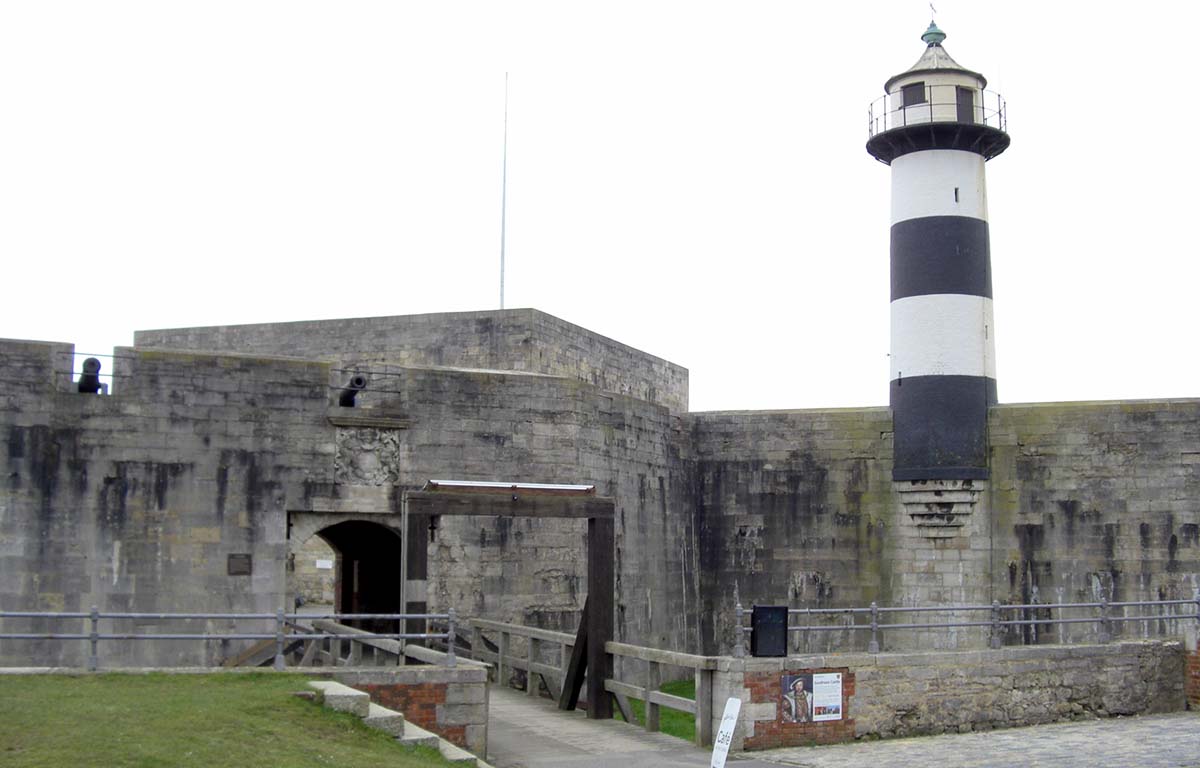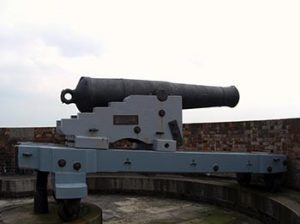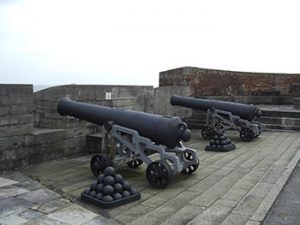
by Matthew Adams
Southsea Castle is a coastal fortification that dates back to the 16th century. Located on the coast of Clarence Esplanade, a grassy patch in Southsea beside the D-Day Museum, the castle remained a coastal fortification for centuries up until the world wars of the 20th century. It was constructed to guard the narrow coastal waters of the Solent from enemy navies, and was stocked with a considerable assortment of guns to blast ships out of the water. Today, some of that artillery remains in the Southsea Castle Museum.
By the early 19th century, the British Empire was at war with Napoleonic France. France planned for a potential invasion of Great Britain. As such, modernized coastal defences, as well as a larger number of Royal Navy ships, became increasingly essential for the British. By then Southsea Castle was a somewhat outdated coastal citadel loaded with a lightweight collection of artillery such as 32-pounder and a few 6-pounder guns. The castle’s grand battery had also been eroded. The coastal ‘fortress’ would probably have had little impact on any French warships had they passed it.
Renovation proposals for the castle were proposed as early as 1804, but subsequently delayed. It was not until 1813 that Southsea Castle was revamped, with parts of the fortification reconstructed. Major-General Fisher was influential in the modernization of the castle. From 1813 the general rounded the south coastal bastion, and reconstructed the northern bastion facing inland. This made space for barrack rooms and gun platforms above them. The top of the castle’s keep was also squared off with the removal of outdated watchtowers, and an additional four positions were established for 24-pounder guns.
Despite the defeat of Napoleon, another decline in Anglo-Franco relations during the century ensured that the castle was further expanded from 1850 – 1869. Part of the expansion included the addition of the east and west batteries. Located just beyond the castle, the east and west auxiliary batteries have since been landscaped; and no artillery is now included there. As warship gun ranges expanded four sea forts were also constructed in the Solent, which included up to 54 guns. Then they could pick off the ships if they were outside Southsea Castle’s range.
The rise of aircraft and missiles ensured the decline of coastal artillery in the army during the post-war period. As such, Southsea Castle has since been an artillery museum. Today, the castle museum is largely dominated by artillery from the 19th century period. One notable exception is the 24-pounder cannon within the castle’s courtyard that went down with the Royal George ship in 1782. That was later recovered by a diver in 1834, and the artillery was not a part of the castle’s armament.
Just outside the entrance of this castle are two 19th century artillery pieces. One is an 1853 68-pound smooth-bore muzzle-loader of 96 cwt. Those artillery pieces were among the last of the smooth-bores, and were also among the largest iron guns. These were guns that were deployed in the Crimean War against the armies of the Russian Empire, and it is believed that the artillery piece outside Southsea Castle was one included in the Siege of Sevastopol.
To the right of the entrance is an artillery piece introduced in 1868. That is a 9-inch RML Armstrong-Fraser Gun of 12 tons. These were primary and secondary armaments for British battleships, and were also incorporated for coastal defence. In the 1880s and 1890s some were adapted as high-angle coast defence guns. The guns were a big part of the 1860 Royal Commission heavy armaments. At Southsea Castle they were positioned along the west auxiliary battery, which was constructed in the 1860s to boost the castle’s fire-power.
Behind these guns is a bridge that crosses the castle’s dry moat up to the entrance. The entrance leads to the castle’s small courtyard, otherwise the bailey, which is surrounded by four granite gun platforms which slope down towards the parapet. They were sloped to absorb the recoil of the guns.
In the centre of the bailey is the castle’s square keep that is now the primary building of the museum which includes a range of artillery, models and other artefacts. The keep has a red-brick interior and vaulted ceilings which were added to reinforce it against enemy shells. Its three metre stone walls further strengthened the castle. A spiral staircase leads up to the roof which has four gun positions, and a flag mast for raising and lowering flags.
On the ground floor of the keep there are two guns located in front of the castle’s windows. One is a rifled 3-pounder gun that was introduced in 1876. The gun has a hexagonal cross-section which rotates slightly along the barrel. The design was supposed to enhance the range and accuracy of its shells, although as they occasionally jammed they were not widely adopted artillery pieces. Alongside that there is an 1876 breach-loading gun, which had a solid 3Ib iron shot.
On the secondary floor, the museum includes a 7-inch rifled breach-loading (BL) gun. First introduced during the 1860s, it was quite a big step forward for artillery technology. Unlike many alternatives it was constructed with wrought iron instead of cast iron, and the barrel had a series of tubes. To increase the rate of fire the barrel was loaded at the rear instead of the muzzle. BL guns eventually became the standard coastal artillery pieces across the British Empire, and so they gradually replaced muzzle-loaders at Southsea Castle. Outdated muzzle-loaders were slowly moved by hand across Southsea Common to make way for new BL guns.
Also included within the keep museum are artillery shells and cannon balls. One artillery shell is displayed on the ground floor, which is a studded shell for a ten-inch 1870 RML gun. Stone cannon balls recovered from the castle’s well are also on display in the keep.
 You can go up the castle’s ramparts, or gun platforms, which surround the keep. They provide some great views of the surrounding coastline, especially if you go up the castle’s lighthouse. Along these platforms artillery aligns the fortification’s walls. The majority are located along the north bastion, which faces inland. They are 32-pounder smooth-bore muzzle-loading guns from the Napoleonic period. In 1814, the guns would have been mounted on the landward side of the castle. At the southern bastion, overlooking the sea, there is one 64-pound rifled muzzle-loading gun mounted on a transversing platform. It was constructed in 1872 at the Royal Gun Factory, in Woolwich, and weighs some 3,600 kilos.
You can go up the castle’s ramparts, or gun platforms, which surround the keep. They provide some great views of the surrounding coastline, especially if you go up the castle’s lighthouse. Along these platforms artillery aligns the fortification’s walls. The majority are located along the north bastion, which faces inland. They are 32-pounder smooth-bore muzzle-loading guns from the Napoleonic period. In 1814, the guns would have been mounted on the landward side of the castle. At the southern bastion, overlooking the sea, there is one 64-pound rifled muzzle-loading gun mounted on a transversing platform. It was constructed in 1872 at the Royal Gun Factory, in Woolwich, and weighs some 3,600 kilos.
 Behind the seaward artillery magazines there is a small passageway from inside the castle that runs around the fortification. This passageway, or tunnel, is that of the carponier. The bomb-proof carponier runs around the outer wall of the moat and leads to the counterscarp gallery from where they could fire their guns if required. Myths associated with the castle suggested that the carponier tunnel linked it to Spitbank fort under the seabed.
Behind the seaward artillery magazines there is a small passageway from inside the castle that runs around the fortification. This passageway, or tunnel, is that of the carponier. The bomb-proof carponier runs around the outer wall of the moat and leads to the counterscarp gallery from where they could fire their guns if required. Myths associated with the castle suggested that the carponier tunnel linked it to Spitbank fort under the seabed.
When at the castle you can also visit its shop, and the barracks located under the northern bastion. Don’t forget that Southsea Castle also has a cafщ with drinks and cakes. They are located within the castle’s courtyard area.
Southsea Castle is open from March up to the winter period, Tuesday through Sunday. With a fascinating collection of 19th century artillery, historical re-enactments and great views of the Solent you can have a great day out at the castle. For further details on the museum, check out its website at www.southseacastle.co.uk.
If You Go:
About the author:
Matthew is a freelancer who has produced a variety of articles for various publications and websites such as Swing Golf Magazine, TripAdvisor, Naval History, Artilleryman, dotTech, Bright Hub, Coed Magazine the Washington Post and Vagabundo Travel. Matthew is also the author of Battles of the Pacific War 1941 Ц 1945. Check out the book’s blog at: battlesofthepacificwar.blogspot.co.uk.
All photographs by Matthew Adams
- The Southsea Castle gateway that includes a drawbridge which leads to the courtyard
- The 64-pound rifled muzzle-loading gun atop the castle
- The 32-pounder smooth-bore muzzle-loading cannons atop the castle that were positioned to fire at more inland targets






Leave a Reply
You must be logged in to post a comment.